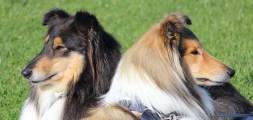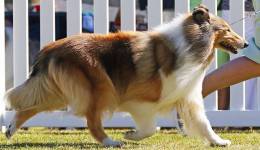Collie (Rough & Smooth)
 Collies (Rough) and Sheltie
Collies (Rough) and Sheltie
The Collie (Rough) and Collie (Smooth) are among Scotland's oldest breeds. Their Spitz like characteristics make many respected dog historians believe they can be traced back directly to the ancient wolf that used to roam Britain. The best known is the Collie (Rough). The Collie (Smooth) is a smooth coated version of the Collie (Rough) with the two varieties occurring in the same litter. The Shetland Sheepdog is basically a miniature of the Collie (Rough).
History of the Collie (Rough) and (Smooth)
 Sheepdog 1847
Sheepdog 1847
Early Herding dogs have existed in Scotland since 2,500 BC when Britain was first invaded. As the British Wolf would have existed at that time, it is logical to assume that these wolves were tamed and trained to become Britain's first herding sheepdogs. Buffon, the French naturalist who classified dogs during the 1700's, believed the Colley was 'superior in instinct to all other breeds'[1].
 Smooth and Rough Colley Dogs 1872
Smooth and Rough Colley Dogs 1872
By the 1800's in the North of England, the more or less pure Collie (then called Colley) was employed by over half the shepherds in that district. But they were improperly called the 'Scotch' Colley. Some showed the total absence of a 'Ruff' or 'Frill', others had an open coat of a pied black and white colour, with a Setter shaped body. Then there were those which resembled an ordinary drover's dog in all respects[6].
 Collie type 'Ambulance Dogs' 1905
Collie type 'Ambulance Dogs' 1905
As explained above, in the early 1900's, Collies varied tremendously. As did their uses! However, their instinct and intelligence was well known and respected. This picture shows of two 'Ambulance Dogs', in their Red Cross jackets, that were supplied to the Russian Embassy in London for duties in the Russo-Japanese War in 1905. The accompanying reports states how intelligent they were, 'for searching for the wounded, with which the millet (corn) fields were strewn', saving many lives[7].
The Collie (Rough) and Collie (Smooth) become Pure Breeds
The 'Scotch Collie' appeared in the First English Stud Book in 1874, possibly due to the founder of the Kennel Club, Mr S Shirley, owning this breed. There is no doubt that the increase in popularity of both the Rough and Smooth Collie was assisted by the favour of the Royal Family. Queen Victoria's kennels at Balmoral included Roughs and Smooths - the first Rough arrived in 1842, and Smooth "Sharp" arrived in 1864 from Scotland, and was the Queen's favourite and her constant companion for years.
 Collie (Rough) sold to USA
Collie (Rough) sold to USA
Described in the Breed Standard as 'a dog of great beauty', once recognised as a pure breed, the Collie commanded extraordinary prices. By 1888 it is recorded that £1,300 was paid for a Collie (Rough) changing hands in England while another, the Rev. Hans F Hamilton's 'Woodmansterne Derek' (pictured) was exported to USA for £1,250[1a]. As these were the highest prices paid for any breed at that time, breeders shifted their focus from a working sheepdog to a breed of sheer beauty. The Collie (Rough)'s fame was further entrenched in 1943 with iconic film 'Lassie-come-home'.
History of Collies (Rough and Smooth) in Australia
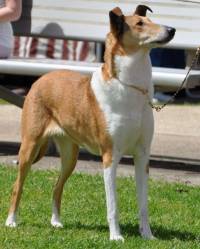 Collie (Smooth)
Collie (Smooth)
Although dog shows began in Australia in 1862, the first attempt to document pedigrees was Tyzacks Annual published in 1912. From 1880 - 1911, this Annual lists 56 Collies (Rough) and 2 Collies (Smooth) imported from Britain. The 'Stud Book' section of the same Annual lists another 82 Collies (Rough) all with the names of their owners, mostly with their sires and dams, and some with their birth dates and/or their show records. This Annual also records the formation of the Victorian Collie Club in 1894[5a]. Many of these Collie (Roughs) are now regarded as icons of the breed's foundation as a pure breed.
 Collie (Rough) 1980
Collie (Rough) 1980
The Collie (Rough) remained popular for the next century and beyond with 210 individual dogs entered at the 1980 Royal Melbourne Show[2]. Today, although primarily a show dog, Collies still retain the natural instinct to herd. There is no doubt that the glamour of this beautiful breed, has added to the popularity, both as a family pet, and a successful show dog.
 Collie (Smooth)
Collie (Smooth)
The Collie (Smooth) was not re-introduced into Australia until the 1970's. Although not enjoying the popularity of his "Rough" cousin, the "Smooth" has all the appeal of the "Rough" but with much less maintenance with his short coat. Although the Collie (Smooth) and (Rough) are produced in the same litter, it requires one parent of the litter to be a Collie (Smooth) for smooth puppies to be produced.
In Australia, the Collie (Smooth) and Collie (Rough) have the same Breed Standard except for the description of the coat. However, the Collie (Smooth) and Collie (Rough) compete for separate Challenge Certificates.
Comparison between the Collie (Rough and Smooth) and the Shetland Sheepdog
As the Collie (Rough and Smooth) are the same breed with the same Breed Standard, they are considered below in the same column, together with a comparison with their miniature 'cousin', the Shetland Sheepdog.
| Collie (Rough and Smooth) | Shetland Sheepdog | |
|---|---|---|
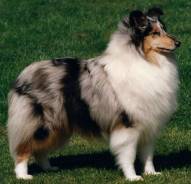 Collie (Rough) Blue Merle Collie (Rough) Blue Merle |
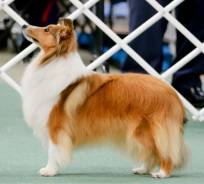 Sheltie (Sable) Sheltie (Sable) |
|
| Size | The Collie stands 56-61 cm (22-24 ins) at the shoulder for dogs and weighs 20.5-29.5 kg (45-65 lbs), and 51-56 cm (20-22 ins) at the shoulder for bitches and weighs 18-25 kg (40-55 lbs). | The Shetland Sheepdog ideally stands 37 cms (14½ ins) at the shoulder for dogs and 35.5 cms (14 ins) for bitches. |
| Colour | The three recognised colours are sable and white, tricolour and blue merle. There may be typical white Collie markings, like a full or part collar, white shirt, legs, feet, tail tip and a blaze on the muzzle, skull or both. | Black and white and black and tan without white markings are recognized colours. In addition, the Sheltie comes in sable, tricolour and blue merle, with or without white markings as a collar, on the chest, frill, legs and the tip of the tail but their absence should not be penalised. However, patches of white on body are highly undesirable. |
| General Appearance | A dog of great beauty, standing with an impassive dignity, its physical structure should be that of strength and activity, but never coarse or cloddy. | A small, long haired, working dog of great beauty, with a symmetrical outline, but never coarse or cloddy. |
|
|
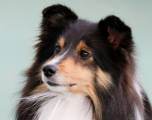 Sheltie Tri Sheltie Tri |
|
| Head Shape | The overall head shape should be that of a well-blunted, clean wedge, being smooth in outline whether viewed from the front or from the side. | Whether viewed from the top or from the side, the overall head shape should be refined and elegant with no exaggerations and resemble a long, blunt wedge, tapering from ear to nose. |
| Skull |
The skull should be flat. The sides of the head taper gradually and smoothly from the ears to the end of the black nose, without prominent cheek bones. |
The skull should be flat, moderately wide between ears, with no prominence of occipital bone. |
| Stop | A perceptible stop between parallel head planes | A slight but definite stop between parallel head planes |
| Foreface | The well rounded muzzle is blunt, but not square. The underjaw is strong, clean cut but not excessively deep. The nose must be black. |
The muzzle is well rounded and of equal length to the skull. The nose, lips and eye rims must be black. |
| Mouth | Normal scissors bite with teeth of a good size | Normal scissors bite with a full complement of 42 sound, strong teeth highly desired. |
 Collie (Smooth) Collie (Smooth) |
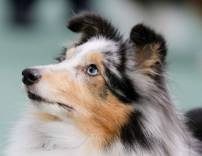 Sheltie Blue Merle Sheltie Blue Merle |
|
| Eyes | Responsible for the Collie's sweet expression, the medium sized eyes should be almond shaped and set somewhat obliquely. They should be dark brown except in blue merles when one or both eyes are blue or blue flecked. | The medium sized eyes are obliquely set and almond in shape. They should be dark brown except for merles, where one or both eyes may be blue or blue flecked as shown above. |
| Ears | The small ears should be neither close together on top of the skull, nor on the side of the head. When in repose they may be carried thrown back. But when alert they are brought forward and carried semi-erect, with the ratios shown as graphics. | The ears are small, moderately wide at base, and placed fairly close together on top of skull. In repose, they may be thrown back but when alert they are brought forward and carried semi-erect with tips falling forward. |
| Neck | The neck should be of fair length, muscular and well arched. | The neck should be of sufficient length to carry the head proudly, and well arched. |
| Forequarters | The shoulders should be well angulated. The forelegs should be straight and muscular with a moderate amount of bone. | The well laid shoulder blades should be equal in length to the upper arm. The elbow should be halfway between the ground and the withers. The forelegs should be straight when viewed from front, with strong, but not heavy, bone. Pasterns must be strong but flexible. |
| Feet | Oval in shape with the soles well padded and the toes arched and close together. | Oval in shape with the soles well padded and the toes arched and close together. |
|
|
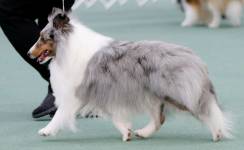 Sheltie Blue Merle Sheltie Blue Merle |
|
| Body |
The body should be a trifle longer than square, the back is firm with a slight rise over the loins. |
The body should be slightly longer than height at withers.The chest is deep, reaching the elbow. The back is level, with graceful sweep over loins to the rear. |
| Hindquarters | The muscular hind legs should be clean and sinewy, with well bent stifles and short hocks. | The thighs should be broad and muscular, the stifle is well bent and the hocks straight when viewed from behind. |
| Tail | The tail should reach at least to the hock joint and carried low when the dog is quiet. The tip has a slight upward swirl but may be carried gaily when the dog is excited, but never over the back. Hair on the tail very profuse. | The tapering low set tail should reach at least to the hock and has a slight upward sweep. It should be well covered with hair and may be slightly raised when moving. |
| Gait | Although moving with its front feet comparatively close together, plaiting or crossing are highly undesirable. From behind, the hocks should be parallel, making the the hind legs look powerful with balanced reach and drive. From the side the action is smooth, with a reasonably long, light and effortless stride. | The Sheltie moves has a lithe, smooth and graceful gait, moving with drive from hindquarters. Pacing, plaiting, rolling or stiff, stilted, up and down movement is highly undesirable. |
| Coat |
Collie (Rough) - the coat should fit the outline of the dog and be very dense. The double coat is straight and harsh while the undercoat is soft, furry and very close. The mane and frill should be very abundant, as are the hind legs above the hocks. Collie (Smooth) - the coat is also a double coat consisting of a short, flat top coat of harsh texture, and a very dense undercoat. |
The double coat is long, harsh textured and straight while the undercoat is soft, short and close. The mane and frill should be very abundant but the coat should fit the body and not dominate or detract from the outline of the dog. Smooth coated Shelties occur but are highly undesirable. |
References and Further Reading
[1] James C Dalgliesh, 'The Collie' - Cassell's New Book of the Dog' by Robert Leighton assisted by eminent authorities on the various breeds. Published by The Waverley Book Co Ltd c 1907. Vol 1, Chapter IX Page 100.
[1a] Ibid.,Page 108.
[2] The Melbourne Royal Show Catalogue 1989, Published by RASV Limited, a Company Incorporated by the Royal Agricultural Society of Victoria, Ascot Vale Pages 61-65.
[5] "Tyzack's Annual" Compiled by T. W.Tyzack and C.S.Turner Published by the Victorian Poultry and Kennel Club 1912 Printed by Bellamine Bros. Printers, 66-70 Flinders Lane Melbourne. Importations Page 56 (Rough) and 2 (Smooth); Stud Book Page 18
[6] J.H.Walsh, under the name 'Stonehenge', 'The Dogs of the British Islands' (Fifth Edition) Published by 'The Field' Office, 346 Strand, W.C.London 1886. Book ll, Chapter l 'Sheep and Cattle Dogs', Chapter 1 'The Colley and other Sheepdogs'. The Colley Dog Page 219
[7] Colonel E H Richardson, "Forty Years with Dogs" Published by Hutchinson & Co Ltd London E 4 (First Edition - no date) Chapter II 'Early Days' Page 38
